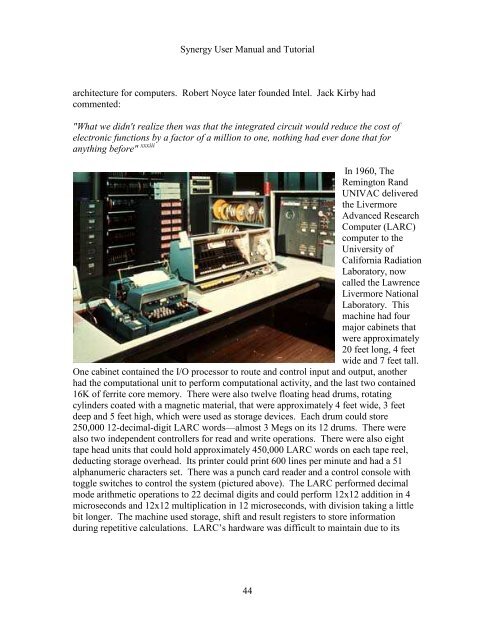Synergy User Manual and Tutorial. - THE CORE MEMORY
Synergy User Manual and Tutorial. - THE CORE MEMORY
Synergy User Manual and Tutorial. - THE CORE MEMORY
Create successful ePaper yourself
Turn your PDF publications into a flip-book with our unique Google optimized e-Paper software.
<strong>Synergy</strong> <strong>User</strong> <strong>Manual</strong> <strong>and</strong> <strong>Tutorial</strong><br />
architecture for computers. Robert Noyce later founded Intel. Jack Kirby had<br />
commented:<br />
"What we didn't realize then was that the integrated circuit would reduce the cost of<br />
electronic functions by a factor of a million to one, nothing had ever done that for<br />
anything before" xxxiii<br />
In 1960, The<br />
Remington R<strong>and</strong><br />
UNIVAC delivered<br />
the Livermore<br />
Advanced Research<br />
Computer (LARC)<br />
computer to the<br />
University of<br />
California Radiation<br />
Laboratory, now<br />
called the Lawrence<br />
Livermore National<br />
Laboratory. This<br />
machine had four<br />
major cabinets that<br />
were approximately<br />
20 feet long, 4 feet<br />
wide <strong>and</strong> 7 feet tall.<br />
One cabinet contained the I/O processor to route <strong>and</strong> control input <strong>and</strong> output, another<br />
had the computational unit to perform computational activity, <strong>and</strong> the last two contained<br />
16K of ferrite core memory. There were also twelve floating head drums, rotating<br />
cylinders coated with a magnetic material, that were approximately 4 feet wide, 3 feet<br />
deep <strong>and</strong> 5 feet high, which were used as storage devices. Each drum could store<br />
250,000 12-decimal-digit LARC words—almost 3 Megs on its 12 drums. There were<br />
also two independent controllers for read <strong>and</strong> write operations. There were also eight<br />
tape head units that could hold approximately 450,000 LARC words on each tape reel,<br />
deducting storage overhead. Its printer could print 600 lines per minute <strong>and</strong> had a 51<br />
alphanumeric characters set. There was a punch card reader <strong>and</strong> a control console with<br />
toggle switches to control the system (pictured above). The LARC performed decimal<br />
mode arithmetic operations to 22 decimal digits <strong>and</strong> could perform 12x12 addition in 4<br />
microseconds <strong>and</strong> 12x12 multiplication in 12 microseconds, with division taking a little<br />
bit longer. The machine used storage, shift <strong>and</strong> result registers to store information<br />
during repetitive calculations. LARC’s hardware was difficult to maintain due to its<br />
44

















